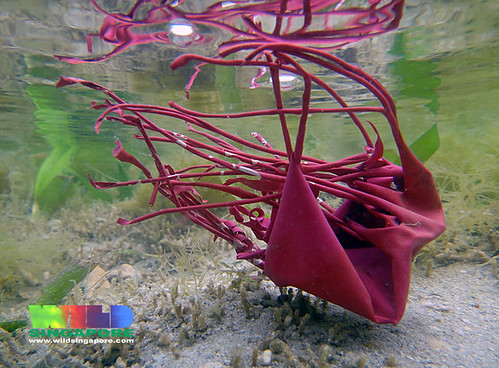 |
| Photo by Chandran V. R. from Badly cut 1m-long sea turtle found dead along Changi Beach by Lydia Lam Straits Times 2 Jan 17 |
What can we do about this? Here's more...
The survey team have often seen large living sea turtles on our shores. Usually, all we get is a glimpse of the sea turtle as it breaks the surface to gulp in air (sea turtles breathe air) before they dive away into the depths out of sight. More about sea turtles in Singapore.
But a sea turtle can get sick eating plastic. This blocks their guts, leading to gases building up inside the sea turtle which causes it to float and unable to dive deep to avoid ships.
Balloons, plastic bags, nylon rope, styrofoam are swallowed by sea turtles which mistake these for jellyfish, according to a study by the Earthwatch Turtles in Trouble program.
 |
| An exploded ballon looks very much like a jellyfish! This was seen at Cyrene Reef. |
How does swallowing soft plastic kill a sea turtle?
from media articles on the Turtles in Trouble report
Sea turtles, because of their anatomy, cannot vomit out the plastic.More about how balloons and soft plastic kill sea turtles, slowly and painfully.
If the plastic does not come out the other end of the sea turtle, it blocks up the digestive system.
The food inside the sea turtle then starts to rot, releasing gases which causes the sea turtle float. The result is called "floating syndrome".
The sea turtle then can't dive to eat, or to escape from predators, or get away from fast moving boats.
The sea turtle also becomes dehydrated.
Even if it doesn't fall prey to predators, or get struck by boats, the sea turtle eventually dies very slowly, over months, from thirst and starvation. "It's a really long, drawn-out, painful death," Dr Townsend said.
Sadly, dead sea turtles are not uncommonly seen. This dead sea turtle was sighted in Sep 2016 during an International Coastal Cleanup Singapore activity at Tanah Merah.
Other threats to sea turtles include oil spills. Like this one in Sep 2016 which was not reported by agencies or in the mainstream media.
What can we do about dead sea turtles?
Shouldn't there be an autopsy of dead sea turtles? So we can find out more about why they died?
As ordinary people, we can do our part to STOP marine litter. See the situation for yourself by joining efforts such as International Coastal Cleanup Singapore. Find out about the SOURCE of marine litter and work to stop trash from entering into the sea in the first place.
You CAN make a difference for our shores!
Explore your shores! Just join any of the many guided activities on our shores, from walks to dives. Come for shore talks and other events. These are updated daily on the wildsingapore happenings blog. Get weekly updates by subscribing to the blog.
Express about your shores! Blog about your trip and share it on social media. Share your photos.
Speak up about our shores. Enjoyed your trip? Tell the organisers, agencies managing the shore. You don't need to write only to complain. Written support of existing habitats will strengthen the case for preserving them. Don't wait until they are at risk!
Act for your shores! Join any of the many volunteer opportunities, more about these on on-going opportunities. Get updates emailed to you by subscribing to feeds from the wildsingapore daily news blogwhich features news, blog updates and volunteer opportunities.
MORE!
About our wild places how to get there, what to see and do, what to prepare.
